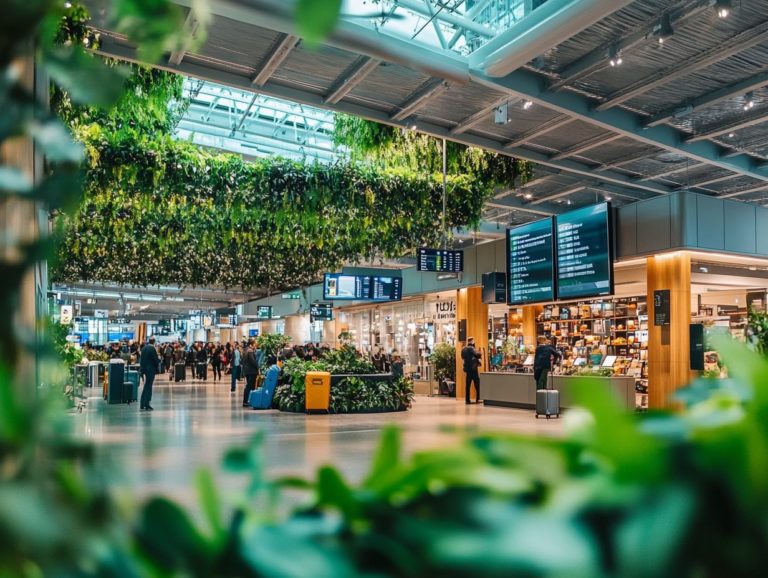Understanding Responsible Travel Certifications
Plant propagation is a rewarding endeavor that allows you to cultivate new plants from existing ones, enriching your indoor garden while keeping costs low.
Whether you re a seasoned plant aficionado or just starting your botanical journey, understanding the various propagation methods from seeds to cuttings can significantly enhance your plant collection.
This article delves into the benefits of propagating indoor plants, outlines effective techniques, shares best practices for success, and addresses common challenges you may encounter along the way.
Get ready to nurture and elevate your green thumb!
Contents
- Key Takeaways:
- Understanding Plant Propagation
- Benefits of Propagating Indoor Plants
- Methods of Propagation
- Best Practices for Propagation
- Troubleshooting Common Issues
- Frequently Asked Questions
- What are the benefits of using effective propagation techniques for indoor plants, especially for cuttings and leaf cuttings?
- What are some effective ways to grow new plants indoors, and how do they relate to successful gardening?
- What is stem cutting and how is it used for indoor plant propagation, particularly for succulents?
- When is the best time to use division for propagating indoor plants, particularly for begonias?
- Can all indoor plants be propagated using the same techniques, including air layering and division?
- How can I ensure the success of my propagation techniques for indoor plants, particularly when using rooting hormone?
Key Takeaways:
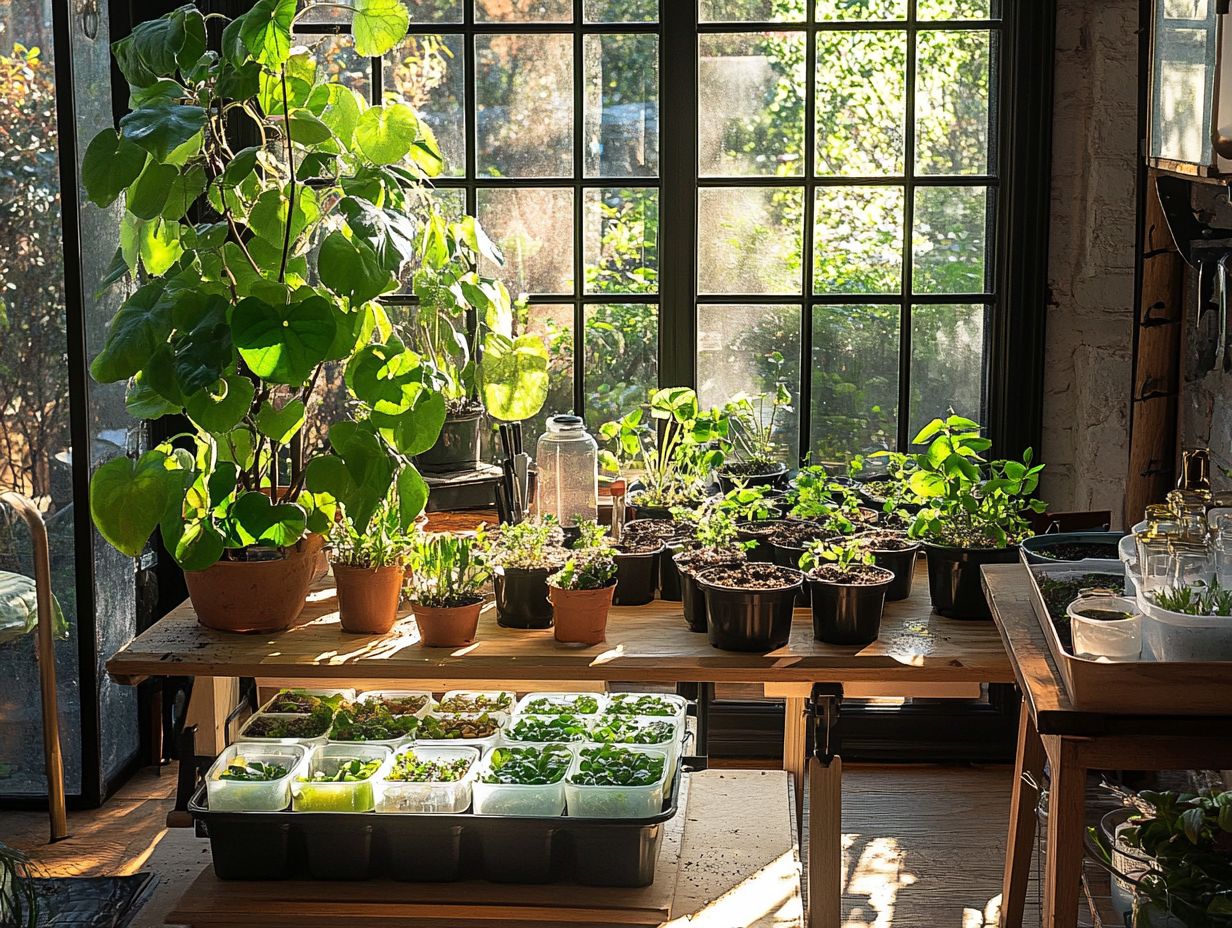
- Plant propagation is the process of creating new plants from existing ones.
- There are many benefits, such as saving money and creating more plants for your home.
- The most common methods of propagation include seeds, stem cuttings, leaf cuttings, and division. Use proper tools and timing for best results.
Understanding Plant Propagation
Understanding plant propagation is essential for gardening enthusiasts. Whether you re diving into the world of houseplants or aiming to expand your collection, mastering propagation techniques enables you to create new plants from cuttings, seeds, or divisions.
Experts like Viveka Neveln and Joseph Tychonievich emphasize that mastering these methods is vital for successful gardening. This not only saves you money but also deepens your connection with nature while promoting sustainable practices.
Whether you’re propagating succulents or leafy greens, knowing how to do it effectively can elevate your gardening journey.
What is Plant Propagation?
Plant propagation is your gateway to creating new plants from existing ones. A variety of techniques allows you to multiply your cherished houseplants and enhance your gardening collection.
This practice not only helps you cultivate more of your favorite varieties but also fosters sustainability within the gardening community.
Basic techniques like cuttings, division, and offsets play essential roles in propagating houseplants such as the resilient aloe and the beloved snake plant.
When you take a leaf or stem cutting from an aloe, you can encourage root growth in just a few weeks. Likewise, snake plants can be divided into smaller sections, each capable of thriving independently.
By mastering these methods, you can cultivate a lush indoor garden while saving money and promoting overall plant health.
This is especially true for popular species like African Violet, Pilea Peperomioides, and Spider Plant.
Benefits of Propagating Indoor Plants
Propagating indoor plants offers a wealth of advantages, ranging from significant cost savings to the sheer delight of expanding your gardening collection. This practice is not only rewarding but also accessible, appealing to both novice gardeners and seasoned horticulturists.
Why Propagate Indoor Plants?
Propagating indoor plants is a brilliant way to expand your collection and explore various species while sharing your gardening passion with friends and family.
This fulfilling practice helps you save money by reducing the need to buy new plants and cultivates a sense of community as fellow enthusiasts trade propagated cuttings.
There s special joy in watching new roots develop and transform into lush foliage. This brings a profound sense of personal accomplishment and a deeper connection to nature.
Adopting this sustainable approach invites you to create diverse indoor ecosystems, enhancing both the beauty and air quality of your space.
Ultimately, the advantages of indoor plant propagation reach far beyond financial savings; they enrich your life and strengthen your connections through shared interests.
Methods of Propagation
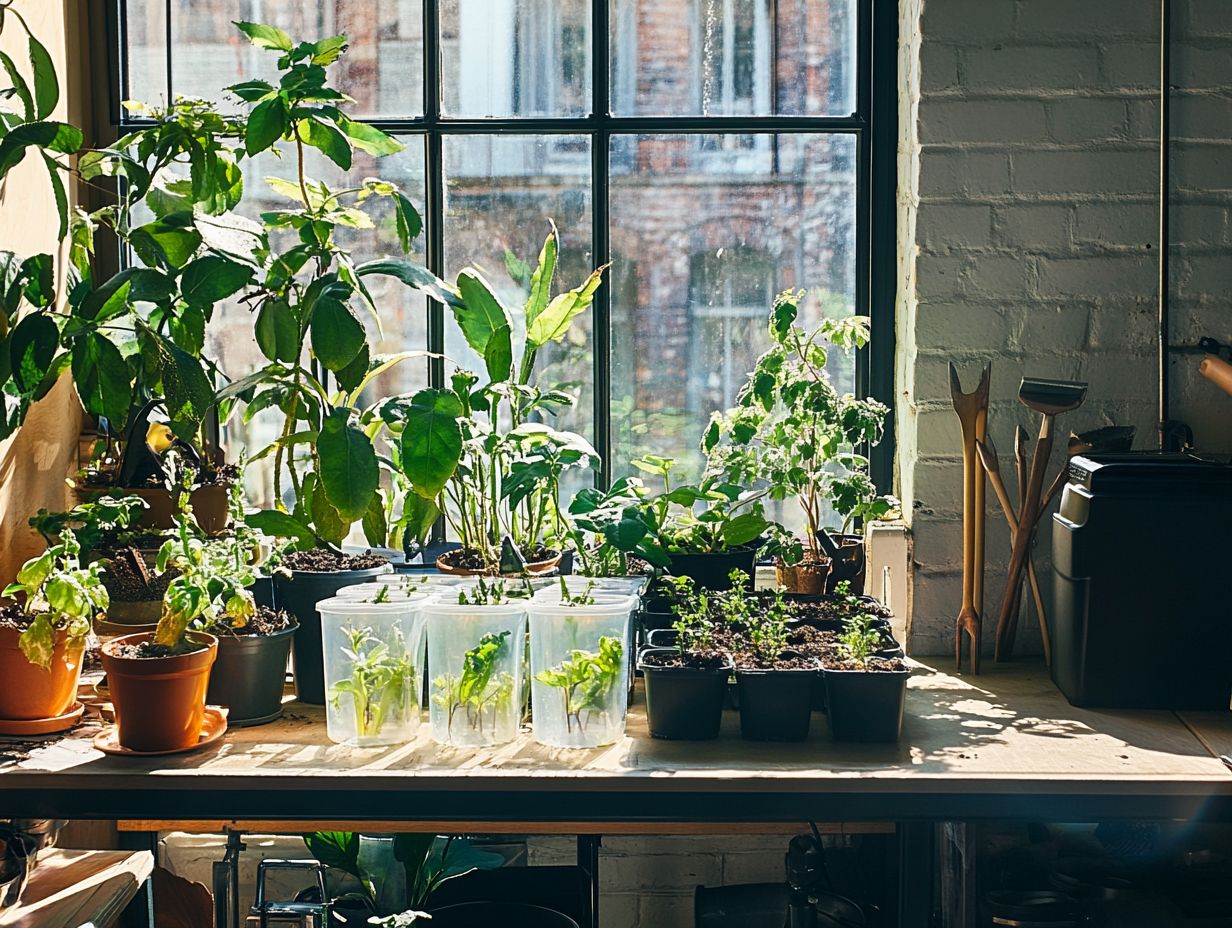
You have a wealth of effective methods at your disposal for propagating new houseplants. Consider techniques such as:
- Seed propagation
- Stem cutting propagation
- Leaf cutting propagation
- Division propagation to expand your indoor garden with ease
- Air layering
- Offsets to enhance your gardening experience
Each method offers unique advantages, allowing you to cultivate a diverse array of plants tailored to your preferences.
Seed Propagation
Seed propagation is a fundamental method in gardening that allows you to grow new plants from seeds. This technique offers a truly rewarding experience for anyone passionate about nurturing houseplants. It not only enables you to expand your collection but also deepens your connection with the plants you cultivate.
Your journey begins with careful selection of high-quality seeds, which you can often find at reputable gardening centers or online suppliers. Once you’ve chosen the perfect seeds, it s time to sow them in a suitable growing medium. Ensure proper drainage and aeration.
After that, your attentive care is crucial. Maintaining consistent moisture and appropriate light levels will encourage successful germination. For instance, when propagating houseplants like succulents or peace lilies, a gentle hand and a bit of patience can lead to thriving new additions to your indoor garden. If you’re interested in growing unique plants, consider exploring the best practices for propagating carnivorous plants.
Stem Cutting Propagation
Stem cutting propagation is a cherished technique for gardeners, enabling the creation of new plants from cuttings taken from vibrant houseplants like Monstera and Pilea Peperomioides. This method also expands your plant collection and offers a cost-effective way to cultivate a variety of species.
The first step is to select a healthy parent plant, ensuring it s free from pests and diseases. Once you ve found a suitable candidate, it s time to prepare your cutting. Choose a stem that boasts several leaves and is at least a few inches long. Make a clean cut just below a node (the part of the stem where leaves grow) to encourage rooting.
After securing your cutting, placing it in a glass of water or soil is essential, as this will spur the growth of roots. During the rooting process, keeping humidity levels up and providing indirect sunlight is vital. For those interested in expanding their indoor gardening skills, learning how to propagate herbs indoors can be beneficial. Regularly checking moisture levels will further ensure that your new plant thrives without stress.
Leaf Cutting Propagation
Leaf cutting propagation is a captivating technique that allows you to use a single leaf from a houseplant, like Echeveria, to cultivate an entirely new plant. This method is a fun way to get closer to nature while expanding your indoor garden.
- To begin, select a healthy, mature leaf that s free from blemishes, ensuring it has the potential to thrive.
- After choosing the perfect leaf, cut it carefully at the base, leaving a clean edge to minimize the risk of disease.
- Next, allow the cut end to dry for a few hours; this promotes callus formation and helps prevent rot once placed in soil.
- When the cut end has dried, lay the leaf flat on a well-draining potting mix, gently pressing it down before watering just enough to keep the soil moist.
With proper care including indirect sunlight and consistent moisture without overwatering you will encourage root formation and, eventually, a new plant. This method is not only simple but also incredibly rewarding.
Division Propagation
Division propagation is a straightforward method that allows you to separate a plant into multiple sections. This technique is particularly effective for plants like Begonia and those with offsets.
By carefully separating the roots and stems, you can create new, healthy plants that are primed to thrive. This technique is best performed during the plant’s active growing season, usually in spring or early summer, giving the divided sections the best chance to establish themselves.
To carry out division propagation effectively, you’ll want to have a sharp knife or gardening shears on hand for clean cuts, along with potting mix that offers the necessary nutrients for your budding plants.
Once you’ve divided the sections, it s crucial to provide proper care, including adequate light, moisture, and a suitable pot size, so those new Begonias and similar houseplants can truly flourish.
Expanding your indoor garden has never been easier; to ensure your plants thrive, learn about the best watering techniques for indoor plants and start propagating today!
Best Practices for Propagation
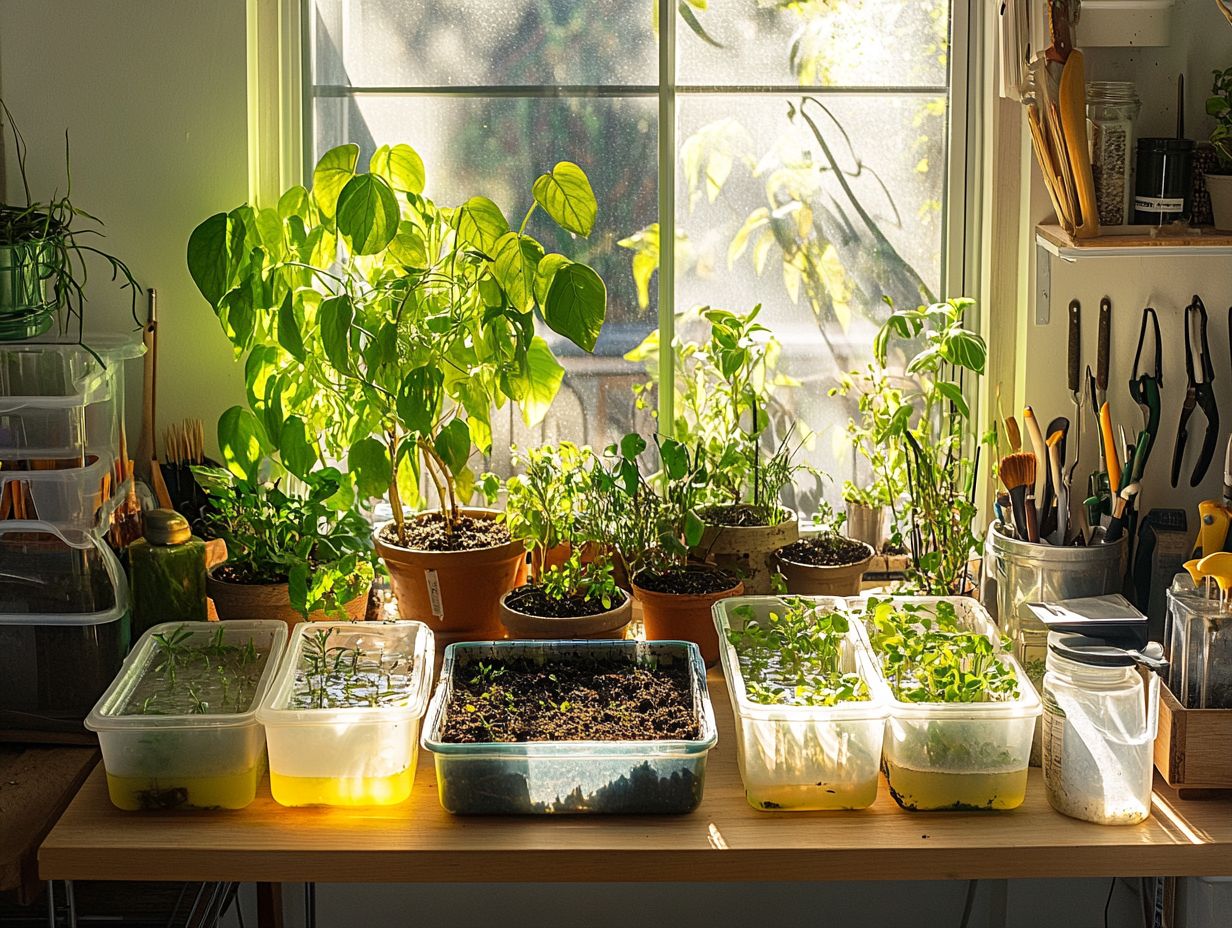
Implementing best practices for propagation is crucial for achieving high success rates and helping plants grow well. This knowledge helps you become a successful gardener!
By mastering these techniques, you can elevate your planting endeavors and truly thrive in your green space.
Essential Tools and Materials
Having the right tools and materials is fundamental for your success in plant propagation. It enables you to care for your houseplants effectively throughout the growing process.
First, you need a high-quality potting mix. This provides essential nutrients and drainage that your plants crave for healthy root development. Incorporating a rooting hormone a substance that promotes root growth can significantly boost your success. This helps your cuttings establish themselves more effectively.
Propagation trays are key; they create a controlled environment for your new plants, preventing moisture loss while allowing for adequate spacing as they grow.
Don’t overlook these other helpful tools:
- Scissors for clean cuts; they are particularly useful when working with stem cuttings.
- Labels to keep everything organized, especially when trying to expand your plant collection.
- Spray bottles to maintain that all-important humidity, a key factor in caring for Aloe and African Violet.
Each of these elements plays a crucial role in creating a thriving propagation setup and ensuring successful gardening.
Proper Timing and Care
Proper timing and care are essential for your plant propagation journey. They enable you to nurture your houseplants with finesse and achieve the results you desire.
Choose the right season to give your plants the best chance to thrive! Spring often emerges as the optimal choice, with its increasing daylight and warmth inspiring growth. This ensures that your cuttings or seeds have the best chance to flourish.
Understanding the specific needs of each plant is crucial; some thrive in a humid environment, while others bask in more direct sunlight. By keeping a close eye on your plants and practicing appropriate watering techniques for different indoor species, you can sidestep common pitfalls like rot, which can arise when the propagation medium is overly damp.
By tuning into environmental cues, you can elevate your success rates in propagating a variety of species, transforming your gardening experience into a true triumph.
Troubleshooting Common Issues
Troubleshooting common issues in plant propagation is crucial for you as a gardener striving for success. By addressing these challenges head-on, you can ensure a more fruitful and rewarding gardening experience.
Preventing and Solving Problems
Preventing and solving issues in plant propagation demands vigilance and knowledge. This enables you to maintain healthy plants and a flourishing collection.
To achieve this, familiarize yourself with the specific needs of each plant type, as conditions can vary significantly. Understanding the optimal light, temperature, and humidity levels is crucial to sidestepping common pitfalls like wilting or rot during the propagation process. Additionally, knowing the best time to propagate your indoor plants can greatly enhance your success.
Employing techniques such as sterilizing your utensils can effectively prevent pest infestations and diseases. Regularly monitoring soil moisture and adjusting your watering schedules accordingly also plays a vital role in this process.
By adopting these best practices, you can establish a solid foundation for successful propagation, ultimately enhancing your overall gardening experience.
Frequently Asked Questions
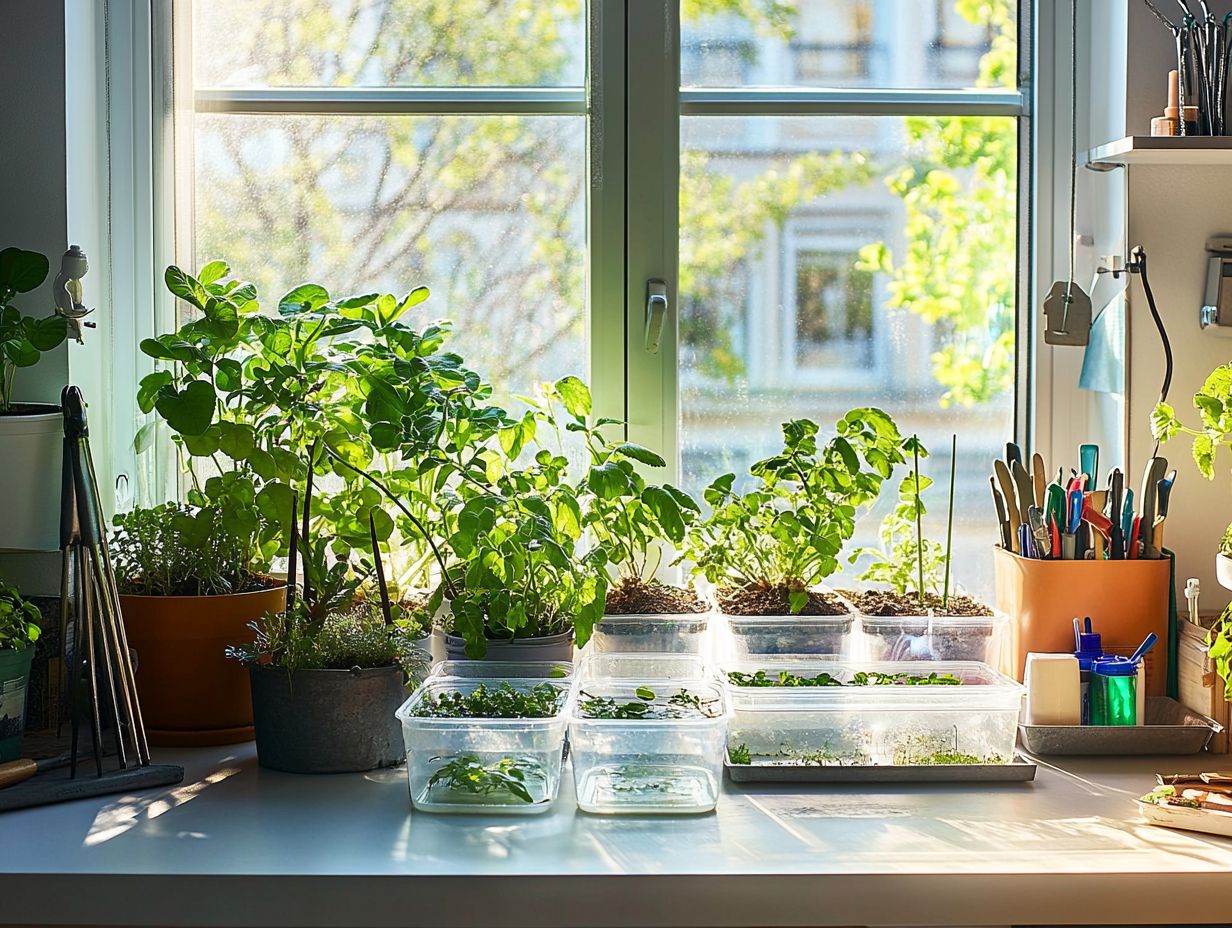
What are the benefits of using effective propagation techniques for indoor plants, especially for cuttings and leaf cuttings?
Effective propagation techniques can help increase the number of healthy and thriving plants in your indoor garden. They also allow you to create new plants from existing ones, saving you money and adding variety to your collection.
What are some effective ways to grow new plants indoors, and how do they relate to successful gardening?
- Stem cuttings
- Division
- Layering
- Propagation through seeds
Each technique has its own advantages and is suitable for different types of plants.
What is stem cutting and how is it used for indoor plant propagation, particularly for succulents?
Stem cutting involves taking a piece of stem from a healthy plant and rooting it in soil or water. This technique is best for plants with woody stems and can result in a clone of the parent plant.
When is the best time to use division for propagating indoor plants, particularly for begonias?
Division works best when the plant is actively growing and producing new shoots, usually in the spring or early summer. Choose a well-established plant for division to ensure success.
Can all indoor plants be propagated using the same techniques, including air layering and division?
No, not all plants can be propagated using the same techniques. For example, succulents are better propagated through leaf cuttings, while spider plants can easily be propagated through division.
How can I ensure the success of my propagation techniques for indoor plants, particularly when using rooting hormone?
To ensure success, use clean and sharp tools and provide proper lighting and watering for the new plants. Choosing the right technique for the specific plant is crucial. Researching specific instructions is a game-changer for your plant’s success!
Start your propagation journey today and watch your indoor garden flourish!


